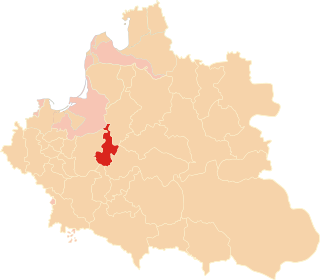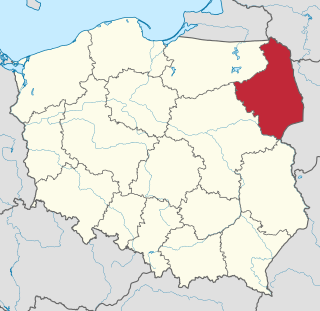
Białystok Voivodeship was a unit of administrative division and local government in Poland from 1975 to 1998, when it was superseded by the Podlaskie Voivodeship. Its capital city was Białystok. It was formed in 1975 from part of the existing Białystok Voivodeship. The region was 10,055 km2 (3,882 sq mi), and its population in 1994, about 700 000 inhabitants. It was divided into 20 cities and 50 municipalities. It bordered with four Voivodeships: Suwałki, Łomża, Siedlce and Biała Podlaska and until 1991 with the Soviet Union, and later with Belarus.

Bielsk Podlaski is a town in eastern Poland, within Bielsk County in the Podlaskie Voivodeship. As of December 2021, the town has a population of 24,883.

Drohiczyn is a town in Siemiatycze County, Podlaskie Voivodeship, Poland. The town has a population of 2,110 and is situated on the bank of the Bug River. Drohiczyn has a long and rich history, as in the past it was one of the most important cities of the region of Podlachia. Currently, it is the seat of Roman Catholic Diocese of Drohiczyn.

Suraż is a town in north-eastern Poland situated in the Podlaskie Voivodeship, seat of Gmina Suraż in the Białystok County.

Brańsk is a town in eastern Poland. It is situated within Podlaskie Voivodeship (province).

New East Prussia was a province of the Kingdom of Prussia from 1795 to 1807. It was created out of territory annexed in the Third Partition of the Polish–Lithuanian Commonwealth and included parts of Masovia, Podlaskie, Trakai voivodeship and Žemaitija. In 1806 it had 914,610 inhabitants with a territory of less than 55,000 km2 (21,000 sq mi), mainly Poles, Lithuanians, Jews and Belarusians.

Podlachia, also known by its Polish name Podlasie, is a historical region in north-eastern Poland. Its largest city is Białystok, whereas the historical capital is Drohiczyn.

Mielnik is a village in Siemiatycze County, Podlaskie Voivodeship, in eastern Poland, close to the border with Belarus. It is the seat of the gmina called Gmina Mielnik. It lies approximately 17 kilometres (11 mi) south-east of Siemiatycze and 88 km (55 mi) south of the regional capital Białystok.
Glinnik is a village in the administrative district of Gmina Brańsk, within Bielsk County, Podlaskie Voivodeship, in north-eastern Poland. It lies approximately 7 kilometres (4 mi) north of Brańsk, 28 km (17 mi) west of Bielsk Podlaski, and 43 km (27 mi) south-west of the regional capital Białystok.

The Podlaskie Voivodeship was formed in 1513 by Sigismund I the Old as a voivodeship in the Grand Duchy of Lithuania, from a split off part of the Trakai Voivodeship. After Lithuania's union with the Kingdom of Poland in 1569 and formation of the Polish–Lithuanian Commonwealth, the voivodeship was transferred to the Polish Crown, where it belonged to the Lesser Poland Province of the Polish Crown.

Gmina Brańsk is a rural gmina in Bielsk County, Podlaskie Voivodeship. It is located in north-eastern Poland.

Gmina Wyszki is a rural gmina in Bielsk County, Podlaskie Voivodeship. It is located in north-eastern Poland.

Podlaskie Voivodeship is a voivodeship (province) in northeastern Poland. The name of the province refers to the historical region of Podlachia, and part of its territory corresponds to that region. The capital and largest city is Białystok.
Mień is a village in the administrative district of Gmina Brańsk, within Bielsk County, Podlaskie Voivodeship, in eastern Poland. It lies approximately 10 kilometres (6 mi) west of Brańsk, 34 km (21 mi) west of Bielsk Podlaski, and 50 km (31 mi) south-west of the regional capital Białystok.
Oleksin is a village in the administrative district of Gmina Brańsk, within Bielsk County, Podlaskie Voivodeship, in north-eastern Poland. It lies approximately 8 kilometres (5 mi) south-east of Brańsk, 22 km (14 mi) west of Bielsk Podlaski, and 50 km (31 mi) south of the regional capital Białystok.
Pietraszki is a village in the administrative district of Gmina Brańsk, within Bielsk County, Podlaskie Voivodeship, in north-eastern Poland. It lies approximately 8 kilometres (5 mi) north-west of Brańsk, 30 km (19 mi) west of Bielsk Podlaski, and 45 km (28 mi) south-west of the regional capital Białystok.
Świrydy is a village in the administrative district of Gmina Brańsk, within Bielsk County, Podlaskie Voivodeship, in north-eastern Poland. It lies approximately 6 kilometres (4 mi) north of Brańsk, 23 km (14 mi) west of Bielsk Podlaski, and 41 km (25 mi) south-west of the regional capital Białystok.
Załuskie Koronne is a village in the administrative district of Gmina Brańsk, within Bielsk County, Podlaskie Voivodeship, in north-eastern Poland. It lies approximately 7 kilometres (4 mi) north-east of Brańsk, 20 km (12 mi) west of Bielsk Podlaski, and 41 km (25 mi) south-west of the regional capital Białystok.

Throughout its early history, the area comprising the current day Podlaskie Voivodeship was inhabited by various tribes of different ethnic roots. In the 9th and 10th centuries, the area was likely inhabited by Lechitic tribes in the west and south, Baltic (Yotvingian) tribes in the north, and East Slavic tribes in the east. Between the 10th and 13th centuries, the area was mostly divided between Poland, Ruthenian principalities and the Yotvingians, and by the 14th century, it was divided between the Kingdom of Poland and the Grand Duchy of Lithuania. In 1569, after the Union of Lublin, most of the current voivodeship was reintegranted with the Kingdom of Poland.

Bielsk Land, was an administrative unit (ziemia) of the Grand Duchy of Lithuania, Kingdom of Poland and the Polish–Lithuanian Commonwealth. Created in 1413, it originally belonged to the Lithuanian Trakai Voivodeship. In 1513, it became part of newly created Podlasie Voivodeship, and from 1569 until 1795, it belonged to the Kingdom of Poland.





















